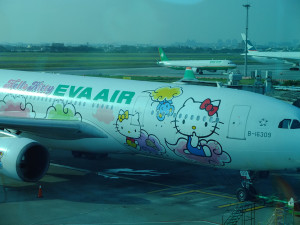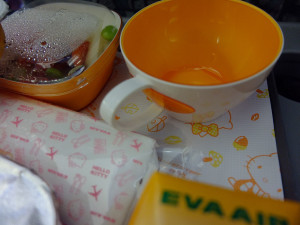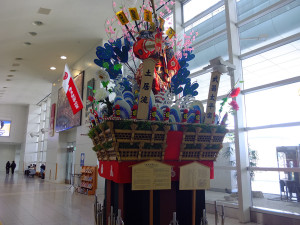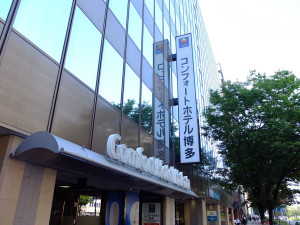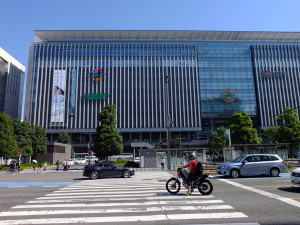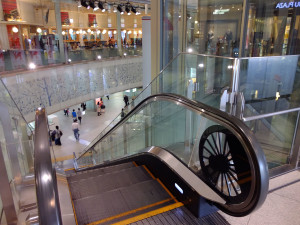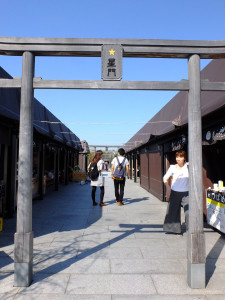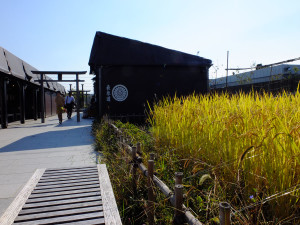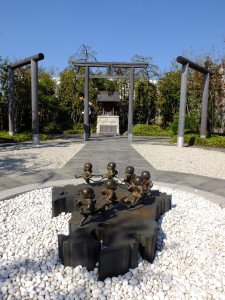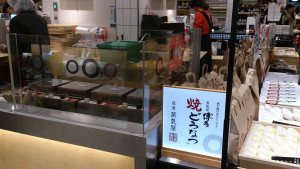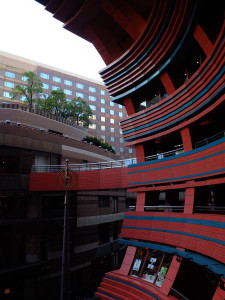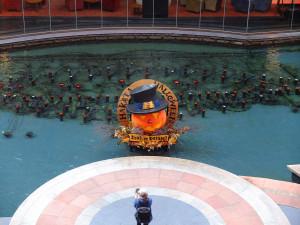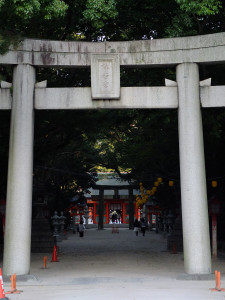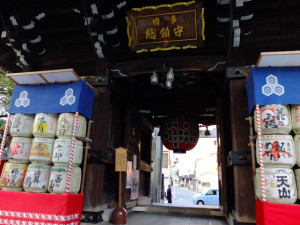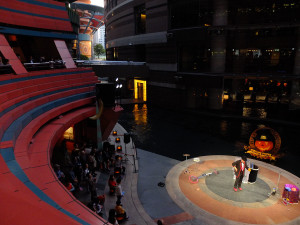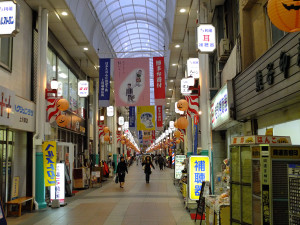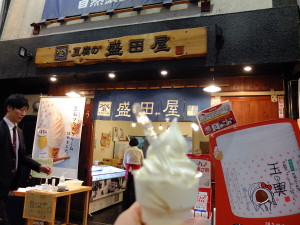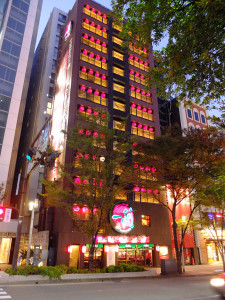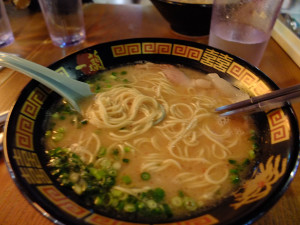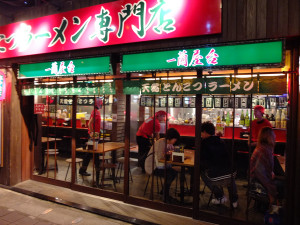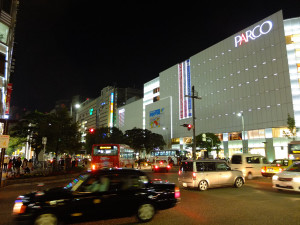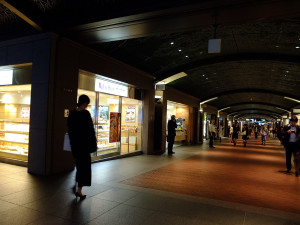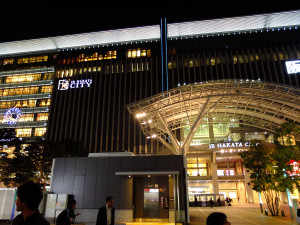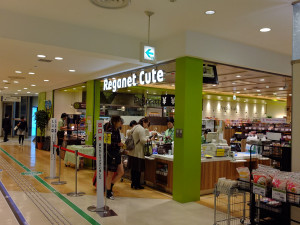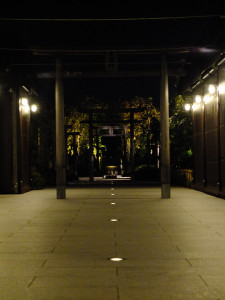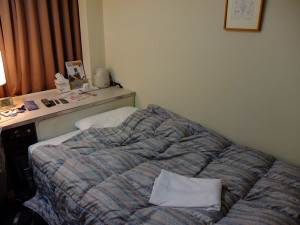There’s a few choices of airlines to Fukuoka, I decided on EVA as it had the best timetable, morning flight out and noon return, and reasonable fares.
It was somewhat of a surprise when I saw the Hello Kitty jet. I kind of knew EVA flew jets with Hello Kitty deco for flights to Japan, but I didn’t realize they flew it on the Fukuoka route. Hello Kitty jets are more than just a paint job. The internal decorations and meal utensils are also Hello Kitty themed. Think my cousins actually went out of their way to fly on a kitty jet a while back on their trip.
Not a kitty fan myself (I like Cinnamoroll better).
The food is better than what I’m used to (cough, Cathay…). Then again this is a Taiwanese airline so you’d expect them to cater for local taste.
The two hour flight passes in a blink of an eye and the plane touches down lightly in Fukuoka.
Fukuoka airport has the international terminal on the otherside of domestic, separated by the runway. A strange choice, but such is often the constraint of urban area airports. Because of this, unlike domestic which is served by the metro, international is only served by buses to the city centre.
A free shuttle does run between the terminals and many people uses it to get to domestic to take the metro.
This time I take a third option I’ve never used before on my travels. A taxi ride.
Fukuoka airport is really close to Hakata station, a bus ride is 260Y each, 780 for all three of us while a taxi ride is about 1500Y. Saves the trouble of waiting for a bus or hauling luggage, and being dropped off directly at the hotel (even if it is just across the road from the station), going by taxi is well worth the extra little bit of money.
But first thing first, money. With the trusted Citibank Plus debit card I withdraw some cash from the ATM. No forex or withdraw fee, it makes travelling so painless, no need to guess how much money to exchange beforehand before leaving home, and no need to worry about ever running out of cash, especially in a very cash dependent place like Japan.
Our hotel in Hakata is the Comfort Hotel. It’s not the greatest hotel, a little old but its location is impeccable, right across the road from the station.
After dropping off our luggages we head out to the station complex for the important task of picking up the rail pass. It took much longer than I expected, the girl at the counter was very friendly but possibly due to some kind of processing restriction, she had to contact some kind of processing office in order for me to pay with my credit card. Had I known it would be this troublesome I would have paid with cash, which I had already withdrawn enough of in case the card gets rejected.
Anycase I got the rail passes and reserved seats for our train up to Matsue tomorrow. I asked for seats on the Japan sea side, and the girl was more than helpful in obliging, even double checking the train’s seating plans to ensure that.
The original plan was to have a late lunch, have a look around then go back to the hotel to check in at 3pm. We didn’t feel hungry yet so just headed up the escalators.
Much like many other stations in Japan the Hakata station complex consists of several “wings”, department stores and arcades and restaurants. What makes it special is its roof garden which hosts a shinto shrine dedicated to the god of railway safety. We took the slow way up floor by floor, browsing along the way.
The roof garden consists of two halves, on one side is a small courtyard lined with a few tables, there are a few tricycles lying around for kids, and surrounding the courtyard a mini railway track that costs 200Y a ride. Overall a playground for the children while adults are off shopping.
On the other side is the shinto shrine. What I really love about Japan is how they treat things with such respect and properness. A shinto shrine atop a station shopping complex is more attraction and symbolic than actual worship. Yet not only does it have its own set of toriis, a pilgrim path with shops, it even has a small patch of rice field for growing rice dedicated to the gods. A well found balance of modern life and tradition without coming across as jarring or patronizing.
After the rooftop we head down to B1, customarily where the supermarket and other food related stores are. Not sure if it’s because it’s Friday afternoon or it’s always this busy, many of the various stalls were giving out food tastings and Dad had a good time sampling various snacks and sakes. We also bought a baked donut, and some kind of rice cake to try out. Finally Dad got a box of sushi to bring back to the hotel.
It’s hard to say where to place Comfort Hotel amongst the hotel chains. Better than Smile but not quite as good as Super, they do have complimentary drinks but doesn’t quite have the drink variety nor is their breakfast as good in terms of quality (variety is better). About equal in terms of rooms, and depending on whether you prefer interactions with hotel staff it can be better and worse at the same time. Personally I quite like the minimal contact security code access style of Super Hotel, though with Comfort you can be sure of the counter being staffed and you can drop off luggages with less hassle.
While having a short tea break with sushi bento, mom realizes we have no cups for the sake (doesn’t like using hotel cups). She talked about being on the lookout for place selling disposable cups, then I mentioned that there’s a Daiso right next to the station in the bus centre. That’s where we went first after the break. Then we heads west, the plan is to do a rough curve from Canal City through the nearby shopping arcade, cross over the riversides where roadside stalls that Hakata is famous for are located, then finish at the Tenjin shopping area and return via the metro.
It’s more or less just a tour the city and window shop, a little aimless, there’s not quite enough time to go further out from the city centre.
Canal City is a large shopping complex about 5 minutes walk from the station, so named as it has a canal going through its centre. Its centre consists of a convex ball shaped amphitheatre like space, currently occupied by a giant pumpkin. I knew Japan loved Halloween, a holiday mostly forgotten in Australia now, but I was not prepared for how much they embraced it, as I found out throughout this trip. Halloween decos were everywhere, almost as much as Christmas and Valentine. Maybe for a culture so usually restrained, holidays become a venue to express themselves?
I leave my parents at Canal City while I go check out the nearby shinto shrines. I bought data sims for them this time (got a good deal while they were on sale), even if I go off on my own they can still reach me and there’s no need to pre-agree on when and where to meet up.
Sumiyoshi shrine, gods of the seafaring and Kushida shrine that worships the ruling gods in shinto and hosts some of the biggest festivals around Hakata.
I wanted to visit them because I find that urban shrines often hold surprises, tucked away amidst the concrete surroundings a piece of tranquil calm separate from the modern world.
When I got back to Canal City my parents were watching a magic/tricks performance in front of the big pumpkin. Apparently I also missed the water dance, a major attraction for Canal City. Ah well.
The north side of Canal City connects to the Kawabata Dori shopping street, a pedestrian shopping arcade about half a kilometres long.
Shopping arcades are common in Japan, each have their own unique atmosphere and flavour. Some have a lot of izakaya (japanese bar), others more grocery focuses, some more about games and entertainment, others a mish mash.
Kawabata Dori leans slightly more food focused, izakaya, restaurants and food stores. We pause before a soybean specialty store which sells various soybean derived food products and even cosmetics. Their soymilk soft cream was fantastic and I highly recommend.
At the end of the shopping street we turn left toward Tenjin. The original plan was to either find something to eat from the yatai street stalls, or falling short of that get to Tenjin and find a restaurant. I’ve made short lists of potential places to eat for all the locations we’ll be visiting, sushis, meal sets, tonkatsus or dons.
If one look at the list you’ll see a notable absense, there’s nothing ramen. After last time I didn’t bother to note down ramens since my parents don’t like them. It was pure coincidence and chance that my parents asked me what was that building with all the lanterns on the other side of the road.
Oh that’s just the flagship store of Ichiran ramen, one of the most well known ramen chains. I casually answered.
I knew Ichiran’s flagship store was somewhere around Hakata but it didn’t even occur to me to check where it is. Lucky. I started taking photos then my parents said why don’t we try that then, if it’s that famous.
Well then… I suppose if they’re interested. Seems like I have a habit of randomly endding up in Ichiran.
Interestingly the flagship store in addition to their trademark style of individual counters, also have more traditional tables. I opted for the tables so it’ll be easier to help my parents order (even if for the counter seats they can fold the dividers between the counters). Also because I didn’t feel like climbing stairs.
Since my parents always complained that ramens are too salty, I suggested they make everything light, both flavour and thickness and no chilli. The staff come around and took our orders. It’s a shame they also forego the order ticket machine in their yatai style table seatings, I love punching buttons and seeing meal tickets fall out.
Turned out my parents actually quite liked the ramen, feeling the stock’s flavour to be just right. So maybe Ichiran is popular amongst Taiwanese for a reason, maybe it suite our taste more? I wonder if I should show them that godly curry milk ramen place in Aomori.
With dinner accidentally dealt with, we continue on to Tenjin directly. I figured there was no point in searching out the yatais street foods if we weren’t going to eat anything. Plus, it was getting close to 7pm, and the Tenjin area starts shutting down at 8.
The Tenjin underground shopping street is more high classed than the average underground shopping street. There’s a fair bit more trinket shops, designer clothes. The ceiling and walls are painted black and the light dimmed to give a more classical and quiet feel to the place. The intersections are decorated with coloured glass frescos.
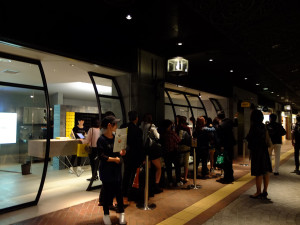
People lining up to buy custards. The line actually breaks and resumes further down up a flight of stairs.
I can see why the place is popular with some people, if one liked shopping one could spend an entire day here.
We return to Hakata station with the metro, 200Y for three stops. It could be the lighting but the metro feels somewhat aged compared to say Tokyo or Nagoya.
We checked out the supermarket again looking for some fruit. At this season it’s basically just apples and mandarins, but the mandarins were selling at like 800Y a bag. Immediately my parents regretted not having bought cheaper ones back at Kawabata Dori. We returned to the hotel empty handed.
Puzzled, mandarins are supposed to be about 300Y a bag, I know because I had like 3 or 4 bags of them last year. Convinced it was just the supermarket at Hakata City being way too high class, I head out again on my own in search of a more reasonable supermarket.
Using a Japanese supermarket search website, I learned that there’s another one in the basement of the bus centre. It’s called Reganet Cute, a supermarket aimed at office workers with everything in small packs. The mandarins here was about 290Y a bag, much more reasonable.
Feeling quite good about accomplishing my goal, I head up to the garden atop Hakata City once more to check out the shrine and the views of the city at night. Because of the nearby airport there are no highrises near Hakata station. The station itself, at 11 floors, is already one of the tallest building around, but sadly not significantly taller than the surroundings to provide a good view.
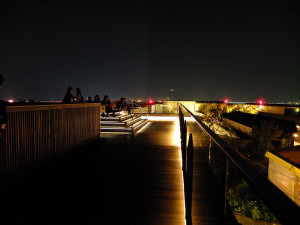
Roof top viewing platform, very popular with couples. There’s constantly a security guard standing watch nearby.
Back to the hotel, I hand over the mandarins to my parents and retire for the night.
